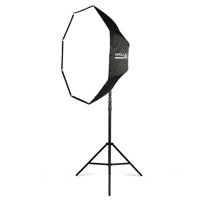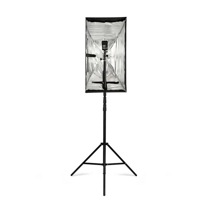Where to for Pocket Wizard's eTTL offerings?
/I made substantial investments in the Pocket Wizard TTL radios to use with my Canon cameras over the last couple of years. I bought the Mini TT1 to use as the primary transmitter and a number Flex TT5s as receivers, and an AC3 zone controller. I've also purchased the AC7 hard shield because the Canon 580EX II is known to be susceptible to radio interference, particularly when installed in one of Westcott's Apollo soft boxes.
 For the most part I've been using the Pocket Wizards in a very general manner for distance triggering of TTL flash. And for the most part, they work quite well. I do find the need to program them through the Pocket Wizard utility to be a nuisance and Pocket Wizard's documentation would need to improve significantly to achieve the level of suck. So, as long as you don't need anything more than triggering, they're fine.
For the most part I've been using the Pocket Wizards in a very general manner for distance triggering of TTL flash. And for the most part, they work quite well. I do find the need to program them through the Pocket Wizard utility to be a nuisance and Pocket Wizard's documentation would need to improve significantly to achieve the level of suck. So, as long as you don't need anything more than triggering, they're fine.
The real point though should be to be able to manage flash zones and output by zone for  eTTL flash just as you can in the manufacturer's infrared systems. I use the term eTTL because I have Canon cameras, but Pocket Wizard does support iTTL for Nikon with the appropriate devices.
eTTL flash just as you can in the manufacturer's infrared systems. I use the term eTTL because I have Canon cameras, but Pocket Wizard does support iTTL for Nikon with the appropriate devices.
Recently Canon replaced their optical triggering system with radio in the new 600EX-RT flashes and the ST-E3 controller. Infrared works fine indoors with line of sight, but it doesn't go around corners and often fails outdoors. Hence the demand for radio. Initially I was surprised at Canon's decision because of the apparent lack of backward compatibility with the older flashes. This has proven to be false as the new flashes can use infrared if you wish. The ST-E3 is radio only, no infrared.
 To get zone control with radio Pocket Wizards, you use the AC3 zone controller and this is where things start to fall down. The AC3 provides for control of three zones, each zone being configurable for Off, TTL and Manual. Manual puts the remote flash in manual mode but still allows for eTTL exposure control on other channels. The theory is that in eTTL mode, you would have +-3 stops of exposure control for each zone, plus whatever control you apply globally on the camera. The reality is that in a lengthy test, this was not so. Despite multiple manipulations and test firing there was no demonstration of a six stop range. Using the AC3 to put the flashes in manual mode actually allows you to vary the power from full to 1/64 power and it works extremely well. But, I really wanted full eTTL control, and did not get it.
To get zone control with radio Pocket Wizards, you use the AC3 zone controller and this is where things start to fall down. The AC3 provides for control of three zones, each zone being configurable for Off, TTL and Manual. Manual puts the remote flash in manual mode but still allows for eTTL exposure control on other channels. The theory is that in eTTL mode, you would have +-3 stops of exposure control for each zone, plus whatever control you apply globally on the camera. The reality is that in a lengthy test, this was not so. Despite multiple manipulations and test firing there was no demonstration of a six stop range. Using the AC3 to put the flashes in manual mode actually allows you to vary the power from full to 1/64 power and it works extremely well. But, I really wanted full eTTL control, and did not get it.
i recall Joe McNally saying at a seminar that Pocket Wizards were decent triggers but that zone control performance was inconsistent at best. Joe is a big fan of Nikon's Creative Lighting System of course, but not a fan of Pocket Wizard. He calls them not ready for prime time, and based on tests across several hundred exposures, I have to agree. This brings me to the question I ask.
A decent powered eTTL flash for Canon or Nikon will run between $400 and $600. Add another $250 for a Flex TT5 receiver and then $100 for an AC3. Comparatively, even Canon's 600EX-RT at $729 retail is a better value, the radio is built in, the user interface is extremely elegant and it works consistently. You will also need a transmitter on the camera and zone manager, so just under $400 for Canon's ST-E3 or about $330 for a Mini TT1 and an AC3. Simplicity suggests that the Canon solution might be better. Pocket Wizard says you can use Flex TT5s to control the power of studio flash in non-TTL mode but it's spurious because it works only with a special receiver add-on for a limited number of studio heads. Since most better studio heads have their own remote system, this is less valuable than one might think out of the gate. For example, Elinchrom's Skyport radio system comes with their head kits and allows power control from the camera in a single transmitter.
So given that Canon is down the road on radio and is anticipated to replace the 430 EX II with an RT model this fall, why would a photographer without an existing Pocket Wizard investment buy Pocket Wizards at all. To even use the new CTL software in conjunction with your light meter, you have to replace the radio transmitter in the meter that you already have for about $140. It's ridiculously expensive for what it is. The latest CTL software still doesn't work with the 5D Mark III or the 1Dx and there is no date announced when the update will be available.
Based upon the state of Canon's movement into radio and the reasonable probability that Nikon will add radio in the next round of flashes, building on their excellent Creative Lighting System, where does this leave Pocket Wizard? Unless there are significant price drops and significant usability improvements, I fear that they are on a slope to irrelevance. Speedlite-ista Syl Arena has reached the same conclusion.
Bowens has ceased delivering PocketWizard receivers for their studio heads because of customer complaints that the Mini TT1 and Flex TT5 units when in transmitter mode won't fire the heads creating customer dissatisfaction, and even with the very nice Plus III transceivers, there are less expensive solutions out there for the studio. Elinchrom's solution is far more elegant and robust.
I have gotten decent use out of my investment and as simple radio triggers for flash, they work consistently and well. So long as you don't care about zones, even the eTTL remote functionality works. But the zone controls are extremely flaky and I had lots of burned shots, despite reading the docs and watching the tutorial videos by Mark Wallace on YouTube. At no time did I experience accurate eTTL output control with the AC-3, completely inconsistent with my experience using Canon's infrared system and now their radio control system. If the internet is any indicator, I'm not alone, and Pocket Wizard's zone eTTL radio model is broken or at best unreliable. i will be keeping my stuff until I can replace all my infrared controlled flashes (a very expensive proposition) and will continue to use the Plus II and Plus III triggers with my studio flashes as they all have Pocket Wizard receivers installed already. What I won't be doing is spending any more money on anything from Pocket Wizard. I'm disappointed and don't see them as a viable solution for truly flexible eTTL flash configurations.











